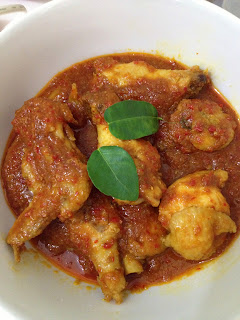I never know that candlenuts can become one of the main ingredients in a dish. As far as I know, candlenuts (or in Malay it is called buah keras) are used in traditional Asian dishes (mainly in Malaysia and Indonesia) to thicken sauces ie satay and sambal. The nut is similar in flavour (though much bitter) and texture to a macadamia nut, which similarly has a high oil content.
 |
| Buah Keras / Candlenuts |
The other day, I was browsing through for a nyonya chicken curry recipe that my late mother used to cook for me and incidentally I stumbled upon this one over here from My Kitchen Snippets. At one glance, it looked similar to the recipe that I was looking for. I clicked, went in and instantly had my heart set on cooking this dish, of course still assuming that it was THE recipe I was looking for.
However, in the midst of preparing the dish, I realized that I was cooking something else. While dishing out onto the plate, I knew that it's gonna be a good one, based on the texture, consistency, color and aroma.
Then came the moment of truth! My wife took her first bite..........mmm, okay-lah, cukup rasa (tasty enough)! As her usual self, always stingy with her compliments, I still could not assume the dish had convinced her.........U-N-T-I-L she took the second piece. PHEW!! I gave out a small sheepish smile.
In the evening, on the dining table, my eldest who had just come back from school tried the dish together with steamed rice. After his last spoon, he went up straight to my wife and blurted out..........."mummy, can you please ask papa to cook some more?"
So, here it is, two 'likes' from two of the most important people in my family. Humbly, I have somehow succeeded in this dish that I feel it's worth trying if you are looking for a nyonya chicken dish.....yes, Ayam Buah Keras/Candlenut Chicken.
The Recipe:
The ingredients:
 |
| Kaffir Lime Leaves |
Candlenut paste (please refer to the recipe below)
1 Lemongrass, slightly smashed
2 pcs Kaffir lime leaves
3/4 cup of water
Salt to taste
Sugar to taste
Method:
1. Heat about 4-5 tablespoon of oil and put in the candlenut paste and fry
until fragrant (this normally take about 10 minutes). Use low to medium
heat and be careful not to burn the paste.
2. Add in the chicken pieces, kaffir lime leaves and lemongrass Coat the chicken
with the paste and keep stirring until the chicken turns opaque.
3. Add in salt, sugar, and some water and stir every now and then.
4. Cook until the chicken is done and gravy thickens slightly. If the chicken is not
cooked but the gravy is starting to dry up, you can add more water.
5. Dish out and serve.
Preparing the Candlenut Paste:
100g fresh chilies (about 10 pcs)
5 candlenuts
100g shallots (about 10-12 pcs)
8g fresh turmeric/kunyit hidup (about 2 inches)
10g shrimp paste/belacan
oil
water
Method:
1. De-seed the fresh chillies if you do not like the paste to be too spicy.
Cut the chillies, shallots and turmeric for easy blending.
2. Put all the ingredients into a blender and add a little water. Blend
into fine paste and set it aside.
BON APPETITE!
The
nut is similar (though “rougher”) in flavor and texture to the
macadamia nut, which has a similarly high oil content. - See more at:
http://theepicentre.com/spice/candlenut/#sthash.cVQyqKJU.dpuf
The nut is similar (though “rougher”) in flavor and texture to the
macadamia nut, which has a similarly high oil content. It is mildly
toxic when raw. - See more at:
http://theepicentre.com/spice/candlenut/#sthash.cVQyqKJU.dpuf
The nut is similar (though “rougher”) in flavor and texture to the
macadamia nut, which has a similarly high oil content. It is mildly
toxic when raw. - See more at:
http://theepicentre.com/spice/candlenut/#sthash.cVQyqKJU.dpuf
The nut is similar (though “rougher”) in flavor and texture to the
macadamia nut, which has a similarly high oil content. It is mildly
toxic when raw. - See more at:
http://theepicentre.com/spice/candlenut/#sthash.cVQyqKJU.dpuf
The nut is similar (though “rougher”) in flavor and texture to the
macadamia nut, which has a similarly high oil content. It is mildly
toxic when raw. - See more at:
http://theepicentre.com/spice/candlenut/#sthash.cVQyqKJU.dpuf




















